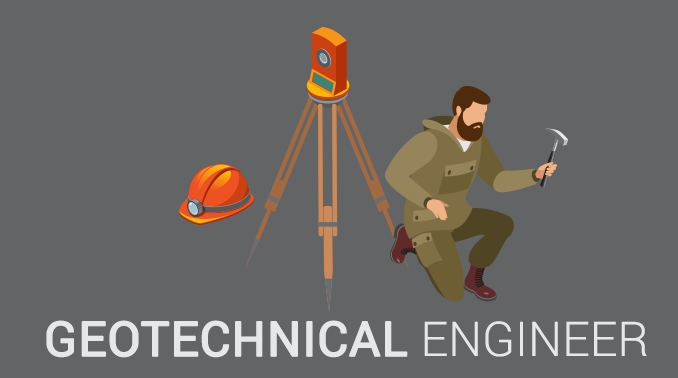Fascination About Geotheta
Fascination About Geotheta
Blog Article
Getting The Geotheta To Work
Table of ContentsThe Buzz on GeothetaHow Geotheta can Save You Time, Stress, and Money.The Ultimate Guide To GeothetaSome Of Geotheta
They work together with civil designers, structural engineers, designers, and other specialists to integrate geotechnical factors to consider right into the overall job style and construction procedure. This calls for effective teamwork, sychronisation, and communication to guarantee that the geotechnical facets line up with the job objectives and fulfill regulatory needs.Mining & Materials Design: Principles of drilling, infiltration prices, and aspects influencing the selection of exploration technique. Attributes of nitroglycerins, shooting systems and blast patterns. Blasting methods in surface area and underground workings. Unique blowing up techniques at excavation borders. Vibration and sound control. Mechanical and continuous methods to fragmentation, including longwall shearing and fullface boring.
Modelling of piece and particle size circulations; comminution as a transfer feature. Comminution modern technology: crushing, grinding, dimension classification. Integrated evaluation of fragmentation and comminution operations. Offered by: Mining & Products Design.
The Ultimate Guide To Geotheta
Bachelor's level programs in civil, geotechnical, geological, and environmental design normally last four years and include general education training courses in English, social scientific research, and the liberal arts, along with programs in innovative maths, architectural geology, and liquid mineralogy. (https://geotheta.edublogs.org/2024/08/02/unlocking-the-world-of-geotechnical-engineers-with-geotheta/)
Geotechnical engineering involves the evaluation of the soil and rock conditions at a certain website, and their effects for the growth of that website. As most structures count on the ground for assistance, it lacks shock that an in-depth understanding of the ground conditions, and the suitability of structure systems, are vital to the long-lasting stability and efficiency of the structure or framework.
Specialising in the examination of geological developments and ground behaviour, geotechnical engineers perform clinical examinations and screening to recognize the influence these geological formations may carry the design and construction of structure, civil and framework jobs. This know-how is critical for the layout and building of structures, roadways, passages, dams, bridges, and water and sewer system.
The geotechnical group at Douglas Partners consistently talk to designers, design designers, programmers, and home builders to make recommendations on style and growth proposals to make certain that the constructed frameworks are appropriately designed for the ground conditions. For instance, the design of footing systems requires to consider the weight of the structure, the capability of the ground to support that weight together with activity resistances and reliable construction.
The smart Trick of Geotheta That Nobody is Discussing
This task is considerably simplified by the use of our Douglas Map geospatial system which makes this info conveniently available in an easy to use internet internet browser user interface. A geotechnical designer will certainly direct the drilling of boreholes and examination pits to gather soil and various other samples, and additionally examine surface attributes and ground exposures to develop a geotechnical model of the subsurface conditions.
Relying on the task kind and ground conditions came across, lab screening might to name a few things evaluate stamina, compressibility, reactivity and/or permeability of dirt and rock examples. Hereafter data is accumulated and collected, the results are used for a geotechnical model of the site, which is generally presented as sections across the site.

A geotechnical examination naturally can just analyze the ground problems at the locations pierced or dug deep into. Natural variations in dirt and rock conditions can take place throughout a website and in between test places. It is therefore excellent practice that the geotechnical designer be preserved throughout building and construction of the task to offer on-site verification that the ground conditions experienced follow the assumptions and advice given in the geotechnical examination record.
Little Known Questions About Geotheta.
Geotechnical designers use their comprehensive expertise of soil and rock to assess risk and resolve troubles on diverse infrastructure projectsGeotechnical engineering is a specialist branch of civil design which takes a look at the practices of planet materials and the application of soil and rock mechanics. Engineer of Record. As a geotechnical designer, you will evaluate the physical, mechanical and chemical homes of dirt and rock in order to create structures, retaining frameworks and earthworks
Geotechnical engineering is closely linked to and overlaps with, both design geology and ground engineering - https://www.edocr.com/v/p4pabymp/ianhammond2191/geotheta. It's possible to specialise in geotechnics or job for a geotechnical company however be referred to as a design rock hound or a ground engineer. As a geotechnical designer, you'll need to: develop and keep relationships with customers and various other experts entailed in the website, throughout each projectmaintain security criteria on site be conscious of expense effects when you make recommendationsstudy geological maps and aerial pictures from a variety of resources and from different time periodsexamine building intends to see how viable they are based upon your understanding of the siteinvestigate threats or geological hazards for the sitesearch for environmentally delicate functions, such as land fill begin to develop accurate and interpretive ground modelsplan area investigationsdrill and analyse examples of bedrock, dirt, groundwater and additional products manage other experts on check it out sitesolve technical problems as they occur, such as unexpected frameworks at drill sitesmonitor problems during and after building and construction to make certain frameworks are stable in the brief and long termadding information collected on site to your preliminary researchcreating geotechnical estimations, illustrations, and two or three-dimensional computer versions translating the datamaking suggestions concerning the suggested use of the site

Report this page